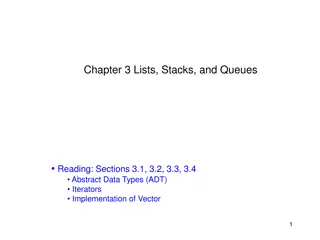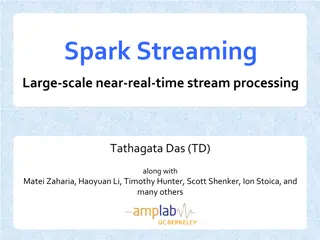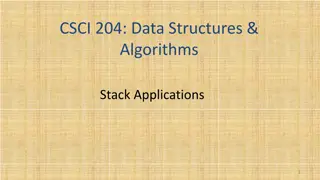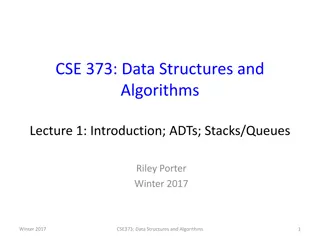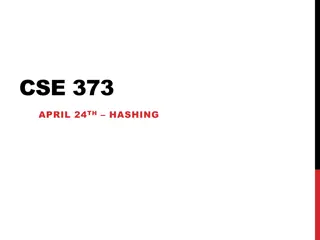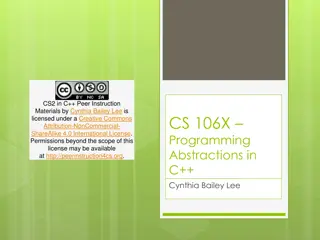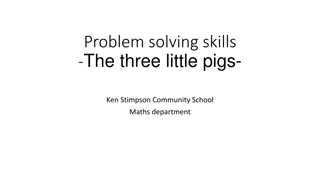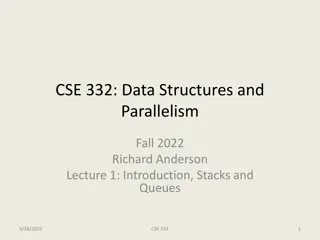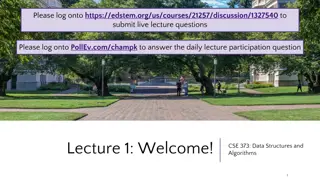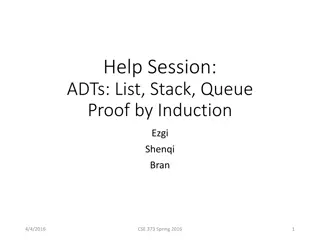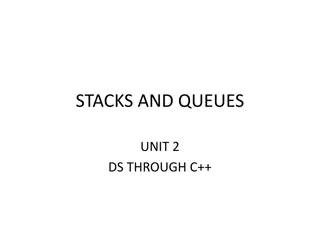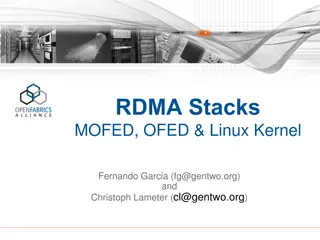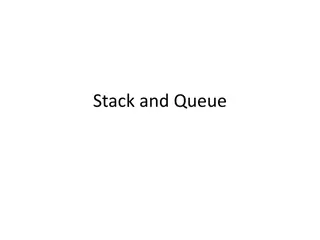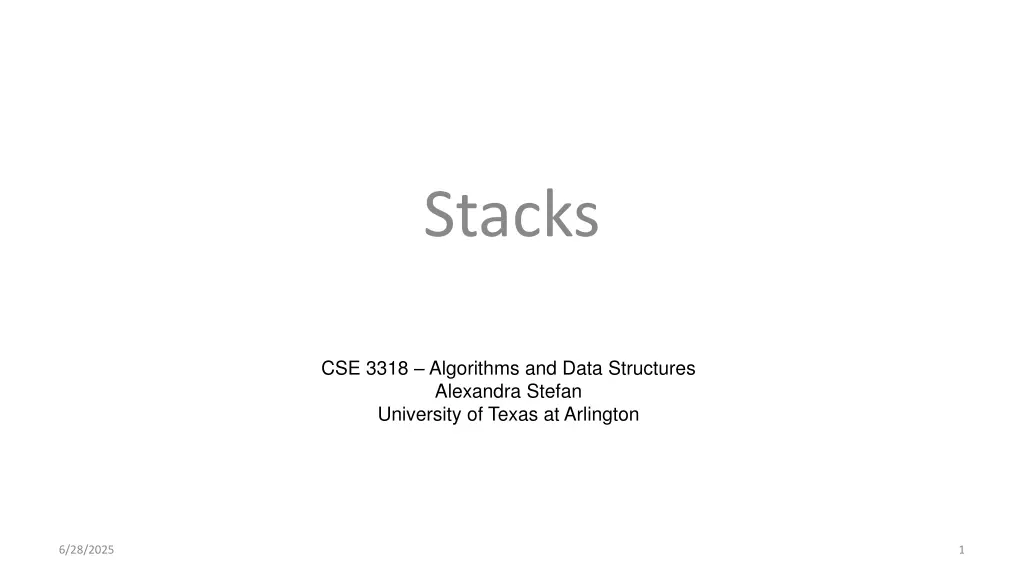
Data Structures and Algorithms Overview
Explore the fundamentals of stacks, queues, and pushdown stacks in data structures and algorithms. Learn about their operations, applications, and implementations, along with practical examples and key terminologies. Dive into the concepts of push and pop operations with interactive exercises and visual aids.
Download Presentation

Please find below an Image/Link to download the presentation.
The content on the website is provided AS IS for your information and personal use only. It may not be sold, licensed, or shared on other websites without obtaining consent from the author. If you encounter any issues during the download, it is possible that the publisher has removed the file from their server.
You are allowed to download the files provided on this website for personal or commercial use, subject to the condition that they are used lawfully. All files are the property of their respective owners.
The content on the website is provided AS IS for your information and personal use only. It may not be sold, licensed, or shared on other websites without obtaining consent from the author.
E N D
Presentation Transcript
Stacks CSE 3318 Algorithms and Data Structures Alexandra Stefan University of Texas at Arlington 6/28/2025 1
General Queues A queue (as a general concept) is a data type that stores a set of objects. Let Item be the type of each object. Operations that a queue supports are: void insert(Queue *q, Item x) - adds object x to set q. Want time complexity (1) Item delete(Queue *q) - choose an object x, remove that object from q, and return it to the calling function. Want time complexity (1) Item peek(Queue q) - see what the object that would be deleted next is, but do not remove it from the queue. Return a copy of it or a reference to it. bool is_empty(Queue q) bool is_full(Queue q) Queue create() - may take initial capacity as an argument void destroy (Queue *q) Queue join(Queue q1, Queue q2) - joins two queues Specialized queues (based on what item delete() removes) Last inserted -> Stack / Pushdown Stack / LIFO (Last In First Out) First inserted -> FIFO Queue (First In First Out) Item with the smallest/largest key (if each item contains a key) -> Priority Queue (Heap) Random item 2
Stack (Pushdown Stack) Main operations: push - Puts an item "on top of the stack". pop - Removes the item from the top of the stack (the last item added). Applications Function execution in computer programs: when a function is called, it enters the calling stack. The function that leaves the calling stack is always the last one that entered (among functions still in the stack). Provide a non-recursive implementation for problems that need a recursive solution Reverse order (e.g. reverse string) Check if balanced parenthesis Applications where you need to retrace your steps (and possibly try a different action). E.g. maze exploration, placing queens on a board. (For such problems it is often easier to write a recursive solution than an iterative one.) Interpretation and evaluation of symbolic expressions: evaluate expressions like (5+2)*(12-3), or parse C code (as a first step in the compilation process). Search methods. traverse or search a graph Check leetcode see what problems require a stack 3
Push / Pop Work sheet Conventions: - value: Push value on stack - * : Pop from stack 15 20 * 30 7 25 * 12 * * push(15) push(20) pop() push(30) push(7) push(25) pop() push(12) pop() pop() Order of operations Empty stack 20 * 30 15 4 Continue with the other operations.
Push / Pop Answers Conventions: - value: Push value on stack - * : Pop from stack 15 20 * 30 7 25 * 12 * * push(15) push(20) pop() push(30) push(7) push(25) pop() push(12) pop() pop() Order of operations Output: 20, 25, 12, 7 25 12 7 7 7 7 7 30 30 20 30 30 30 30 30 15 15 15 15 15 15 15 15 15 15 * Empty stack 20 * 30 7 25 * 12 * 15 5
Terminology Input, Operations, and Output Sequence In this example: The input sequence is: 15, 20, 30, 7, 25, 12 The sequence of operations is: 15, 20, *, 30, 7, 25, *, 12, *, * The output sequence produced by these operations on a stack is: 20, 25, 12, 7 The stack and its changes is shown below. Operations: 15 20 * 30 7 25 * 12 * * 25 12 7 7 7 7 7 30 30 20 30 30 30 30 30 15 15 15 15 15 15 15 15 15 15 * Empty stack 20 * 30 7 25 * 12 * 15 6
Notation conventions for multiple operations and online testing Notation conventions for online testing (in Canvas): Operation:stack after that operation E.g.: : (empty stack) 15:15 (push 15 & stack) 20:15,20 (push 20 & stack) *:15 (pop & stack) 7,34:15,7,34 (push 7 then push 34) ***: (pop,pop,pop) 25 12 7 7 7 7 7 30 30 20 30 30 30 30 30 15 15 15 15 15 15 15 15 15 15 * Empty stack 20 * 30 7 25 * 12 * 15 25 12 7 7 7 30 20 30 30 30 15 15 15 15 15 15 12 (*,*) Empty stack (15,20) (30,7,25) * * shows multiple operations of the same type 7
Exercises Conventions: letter - push(letter) * - pop() 1. Given sequence of operations, show the stack and output: 1. ROS**T*E*X* 2. ROS**T*E***X* (error) 3. SOM**E*T**H*I*NGTO*D**O*** (a longer example) Given input and output sequence, show the push and pop operations Example: given input: CAT and output ACT, the answer is: CA**T* . (Insert * in the input sequence s.t. that these operations give the desired output.) 1. Input: INSATE, 1. Output: SANETI, Operations Sequence: 2. Output: ANSITE, Operations Sequence: (error) 2. 8
Implementing Stacks A stack can be implemented using: Single Linked List see animation Array - see animation Both implementations are straightforward. 9
Single Linked List - Based Stacks Linked List implementation: What is a stack? A stack is a single linked list. push(&stack, item) How? : O(1) wanted (frequent operation for this data structure) pop(&stack) How? : O(1) wanted (frequent operation for this data structure) What type of insert and remove are fast for single linked lists? How many ways can we insert in a list? See animation NULL 10
Single Linked List - Based Stacks List-based implementation: What is a stack? A stack is a single linked list. push(&stack, item) How? : inserts that item at the beginning of the list. O(1) pop(&stack) How? : removes (and returns) the item at the beginning of the list. O(1) See animation 30cd my_list 30cd NULL 11 First node with data
Array-based Stacks Array-based implementation: What is a stack? What will hold the data of the stack? push(&stack, item) How? : Time : O(1) - can we get this? Space: O(1) ? pop(&stack) How? : Time: O(1) - can we get this? Space: O(1) ? Perform operations: push(5), push(8), push(20), pop() 0 1 2 3 4 13
Array-based Stacks Array-based implementation: What is a stack? What will hold the data of the stack? An array. push(&stack, item) How? : insert at the end of the array. Time: O(1) - Yes Space: O(1) pop(&stack) How? : remove from the end of the array. Time: O(1) - Yes Space: O(1) See animation 0 1 2 3 4 14
Defining Stacks Using Arrays We must choose clear conventions for: - How to represent the stack - What an empty stack looks like (NULL or unused space?) - What a full stack looks like - What a stack that is partially filled looks like - What happens at push (how the stack changes) - What to do if stack is full: resize or refuse - What happens at pop (how the stack changes) - What to do if stack is empty Once we chose the below representation (i.e. the data to represent the state of the stack) we must be specific about how it works. For example there are two options for top: - it points to the last element on the stack - it points to the first available cell on the stack (where the new item pushed onto the stack would be placed) See animation index 8 7 6 5 4 3 struct stack_array { int * items; int top; //index AFTER last item int capacity; }; Stack 2 items 40af top 2 capacity 9 8 1 55 5 0 15 40af
Creating a New Stack struct stack_array{ int * items; int top; //index AFTER last item int capacity; }; index 8 7 // struct stack_array S = newStack(9); // in main struct stack_array newStack(int cap){ struct stack_array res; //Item temp[cap]; res.items = temp; // BAD res.items = malloc(cap*sizeof(int)); res.capacity = cap; res.top = 0; return res; } 6 5 4 3 Stack items 40af top 0 capacity 9 2 Do not use an array for items (e.g. items[100])! See the Victim-TAB example showing the difference between Stack and Heap memory. 1 55 0 Why is it ok to return res? (Does it have the TAB pb?) 16
push(5) push(8) push(20) pop() Array-based Stacks empty push(8) push(20) pop() push(5) index index index index index 8 8 8 8 8 7 7 7 7 7 6 6 6 6 6 5 5 5 5 5 4 4 4 4 4 3 3 3 3 3 top top top top top 2 2 2 20 2 2 0 3 2 1 2 8 8 8 1 1 1 1 1 55 5 55 5 55 55 5 55 5 0 0 0 0 0 17
Destroying a stack struct stack_array{ int * items; int top; //index AFTER last item int capacity; }; index 8 void destroy(struct stack_array * S){ if (S!=NULL) { free(S->items); // what happens if S->items is NULL? S->items = NULL; S->capacity = 0; S->top = 0; } } // main // struct stack_array S = newStack(9); // destroy(&S); 7 6 5 4 3 Stack items NULL top 0 capacity 0 2 Do not use an array for items (e.g. items[100])! See the Victim-TAB example showing the difference between Stack and Heap memory. 1 55 0 Why is it ok to return res? (Does it have the TAB pb?) 18
Practice: write push(), pop() ___ push(struct stack_array * myStack, int newItem) index 8 7 6 ____________ pop(struct stack_array * myStack ) 5 4 3 Stack typedef int Item; struct stack_array { Item * items; int top; //index AFTER last item int capacity; }; 2 items 40af top 2 capacity 9 8 1 55 5 0 19 40af
Practice: write push(), pop() void push(struct stack_array * myStack, int newItem) { if ((myStack==NULL) || (myStack->top==myStack->capacity)) printf("Full or myStack is NULL. Exit"); else { myStack->items[myStack->top] = newItem; myStack->top++; // top becomes 3 } } index 8 7 int pop(struct stack_array * myStack ) int temp = 0; // or some other default item value, e.g. -1 if ((myStack==NULL) || (myStack->top==0)) { printf("The stack is empty. Exit"); } else { myStack->top--; // top becomes 1 temp = myStack->items[myStack->top]; // temp has value 8 } return temp; } 6 5 4 3 Stack struct stack_array { int * items; int top; //index AFTER last item int capacity; }; 2 items 40af top 2 capacity 9 8 1 55 5 0 20 40af
Summary and Practice Summary Stack Implementation (code) Time complexity Space complexity Application Practice from leetcode 20. Valid Parentheses https://leetcode.com/problems/valid-parentheses/ 1544. Make The String Great https://leetcode.com/problems/make-the-string-great/ 1190. Reverse Substrings Between Each Pair of Parentheses https://leetcode.com/problems/reverse-substrings-between-each-pair-of-parentheses/ 21
Solution for input CAT, output ACT -> give operations Input CAT: push(C), push(A), push(T) insert pops in between them to get the output ACT Output ACT : C:C A:CA *: C *: T: T *: 22
Solution for input INSATE, output SANETI -> give operations INSATE Ouput: SANETI INS: INS *: IN (S) A:INA *: IN (A) *: I (N) TE: ITE *: IT (E) *: I (T) *: (I) 23

